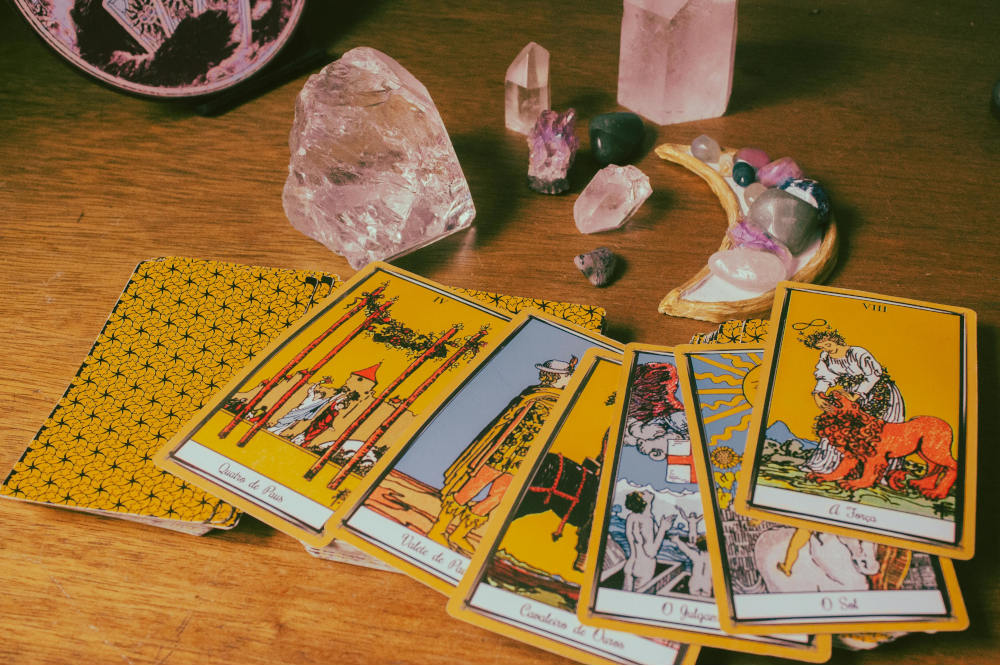
Tarot cards are often linked to the mystical, the spiritual, and sometimes the supernatural. This has led many to wonder: Are tarot cards a form of witchcraft? The answer depends on how one defines witchcraft and how tarot cards are used. While tarot and witchcraft can overlap in some contexts, they are not always synonymous.
In this article, we’ll explore the origins of tarot, the definition of witchcraft, how tarot is used today, and whether tarot qualifies as a magical or occult practice.
Panaprium is independent and reader supported. If you buy something through our link, we may earn a commission. If you can, please support us on a monthly basis. It takes less than a minute to set up, and you will be making a big impact every single month. Thank you!
What Are Tarot Cards?
A tarot deck typically consists of 78 cards divided into two groups: the Major Arcana (22 cards representing major life themes) and the Minor Arcana (56 cards dealing with everyday matters). The Minor Arcana is divided into four suits—Cups, Pentacles, Wands, and Swords—similar to modern playing cards.
While many associate tarot with mystical or occult practices, tarot began as a card game in 15th-century Italy. The game was called tarocchi and was not originally spiritual in nature. It wasn’t until the 18th century that tarot began to be used for divination and esoteric purposes.
This shift happened when European occultists, particularly in France and England, started connecting tarot with astrology, alchemy, Kabbalah, and ceremonial magic.
What Is Witchcraft?
Witchcraft is a broad and often misunderstood term. Its definition varies across cultures, religions, and historical periods. Generally, witchcraft refers to the use of magical or supernatural powers to influence events, communicate with spirits, or manipulate the natural world.
Common Forms of Witchcraft May Include:
-
Spellcasting
-
Rituals or ceremonies
-
Use of herbs, crystals, or symbols
-
Spirit communication
-
Divination (such as using tarot cards, runes, or pendulums)
Witchcraft can be religious (as in Wicca or traditional witchcraft) or secular (used as a personal spiritual or magical practice). It is important to note that not all witches use tarot, and not all tarot readers identify as witches.
The Connection Between Tarot and Witchcraft
Although tarot cards were not originally created as a tool for magic or witchcraft, they are commonly used in modern witchcraft and neo-pagan traditions. Many witches include tarot as part of their spiritual toolkit for purposes such as:
-
Gaining insight or guidance
-
Performing spellwork or rituals
-
Communicating with spiritual forces
-
Exploring the subconscious or inner self
In these cases, tarot becomes a magical tool—a form of divination, which is often considered an element of witchcraft.
Witches may treat tarot cards with reverence, charging them with energy, cleansing them under the moon, or incorporating them into altar setups. In such contexts, tarot becomes spiritually charged and intertwined with magical intention.
Are All Tarot Readers Witches?
Not at all. Tarot readers come from all walks of life and belief systems. While some are witches or follow pagan paths, others use tarot in very different ways, including:
-
Psychological or therapeutic use: Some readers use tarot cards to explore emotions, gain self-awareness, or support mental health, similar to a reflective journal.
-
Artistic or symbolic interpretation: Some people are drawn to the symbolism and archetypes in tarot, using them for creative writing, personal development, or inspiration.
-
Secular or spiritual seekers: Others see tarot as a neutral spiritual tool without engaging in witchcraft or religious rituals.
For these people, tarot is not about casting spells or summoning spirits—it’s about insight, mindfulness, or storytelling. In such cases, tarot may be spiritual or philosophical, but not magical.
Do Tarot Cards Have Power?
This question gets to the heart of the debate. From a magical perspective, some witches believe that tarot cards can hold energy, offer intuitive insights, or serve as a bridge between the physical and spiritual worlds. They may invoke deities, spirits, or ancestral guides during a reading.
From a psychological perspective, others believe tarot’s power comes from the mind of the reader or the querent (person asking the question). The cards act as a mirror, revealing subconscious patterns, desires, or fears.
In this framework, tarot doesn’t contain mystical power on its own—it is a tool for self-reflection, much like dreams or symbolic art.
So while some practitioners attribute magical properties to tarot cards, others do not. The presence or absence of "power" depends on the user's beliefs and intentions.
Are Tarot Cards Occult?
The term occult refers to knowledge of the hidden or esoteric, especially involving the supernatural or mystical. In this sense, tarot cards can be considered part of the occult when they are used for spiritual insight, divination, or magical practices.
Occult thinkers like Aleister Crowley and Arthur Edward Waite (of the famous Rider-Waite Tarot deck) helped shape modern interpretations of tarot, connecting them to astrology, numerology, the Tree of Life, and ceremonial magic. These connections firmly rooted tarot in occult philosophy.
However, not all tarot users are involved in occultism. Today, many people use tarot in secular or non-magical contexts, separating the practice from its mystical roots.
Religious Views on Tarot and Witchcraft
Tarot’s association with witchcraft has caused tension with many religious traditions—especially in Christianity, Islam, and Judaism, where divination and occult practices are often prohibited.
Christianity:
The Bible repeatedly warns against divination and consulting spiritual forces apart from God. Passages such as Deuteronomy 18:10-12 and Leviticus 19:31 have been interpreted as blanket rejections of practices like tarot reading.
Many Christians see tarot as a form of witchcraft—even when used casually—because it involves seeking knowledge or power outside of God's will.
Islam:
Islam also prohibits divination, sorcery, and fortune-telling. The Qur'an and Hadith condemn practices that attempt to access the unseen (ghayb), which is believed to be known only to Allah. Tarot is often included in this category and considered haram (forbidden).
Judaism:
Traditional Jewish teachings caution against sorcery and divination. While interpretations vary among different Jewish groups, the practice of tarot is generally discouraged in Orthodox Judaism due to its association with idolatry and occultism.
Cultural Stereotypes and Misunderstandings
In popular culture, tarot is often portrayed with dark lighting, mysterious music, and fortune-telling tropes. This imagery reinforces the idea that tarot is inherently magical or even dangerous. Similarly, witchcraft is often sensationalized in media, leading to confusion and fear.
In reality, tarot and witchcraft are far more diverse and complex. Some witches are devout Christians. Some tarot users are atheists. And some people are simply curious about spiritual symbols without subscribing to any particular path.
Sweeping generalizations—such as "all tarot is witchcraft"—miss the nuance of how different people approach these practices.
So, Are Tarot Cards Witchcraft?
The short answer is: They can be, but not always.
Tarot cards are not inherently magical. They are printed pieces of paper with symbols and images. What makes tarot witchcraft is the intention, context, and belief system of the person using them.
-
If someone uses tarot to cast spells, perform rituals, or communicate with spirits, then yes, tarot is being used as a form of witchcraft.
-
If someone uses tarot for self-reflection, creativity, or personal growth—without invoking supernatural forces—then it may not fall under any definition of witchcraft at all.
Final Thoughts
Whether or not tarot is considered witchcraft depends on how it's used and what beliefs are attached to it. For some, tarot is a sacred magical tool. For others, it’s a psychological mirror. And for many, it's something in between.
If you are exploring tarot and wondering whether it counts as witchcraft, consider asking yourself:
-
What is my intention in using tarot?
-
Am I seeking spiritual power or simply self-understanding?
-
Does this align with my personal beliefs and values?
Understanding your motivations—and the broader context of how tarot is used—can help you make an informed decision about what tarot means for you.
Was this article helpful to you? Please tell us what you liked or didn't like in the comments below.
About the Author: Alex Assoune
What We're Up Against
Multinational corporations overproducing cheap products in the poorest countries.
Huge factories with sweatshop-like conditions underpaying workers.
Media conglomerates promoting unethical, unsustainable products.
Bad actors encouraging overconsumption through oblivious behavior.
- - - -
Thankfully, we've got our supporters, including you.
Panaprium is funded by readers like you who want to join us in our mission to make the world entirely sustainable.
If you can, please support us on a monthly basis. It takes less than a minute to set up, and you will be making a big impact every single month. Thank you.































0 comments